| Release List | Reviews | Price Search | Shop | Newsletter | Forum | DVD Giveaways | Blu-Ray/ HD DVD | Advertise |
| Reviews & Columns |
|
Reviews DVD TV on DVD Blu-ray International DVDs Theatrical Reviews by Studio Video Games Features Collector Series DVDs Easter Egg Database Interviews DVD Talk TV DVD Talk Radio Feature Articles Columns Anime Talk DVD Savant HD Talk Horror DVDs Silent DVD
|
DVD Talk Forum |
|
|
| Resources |
|
DVD Price Search Customer Service #'s RCE Info Links |
|
Columns
|
 |
Monsters and Madmen
|
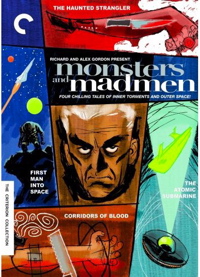
|
Criterion The Haunted Strangler (365), Corridors of Blood (365), First Man into Space (367), The Atomic Submarine (368) B&W 1:33 open matte full frame Street Date January 23, 2006 79.95 (not available separately Reviewed by Glenn Erickson |
Criterion's success has been mainly with acknowledged screen classics; the whole point of picking up a fat disc set on, say, L'eclisse is finding out what the movie is really about from Criterion's authoritative extras. One of the New York based label's few stumbles was when they treated the okay-but-no-classic 50s monster-fest Fiend Without A Face with a kind of reverse-condescension, as if ashamed of it.
Not every movie needs to be justified as Great Art. Criterion has since demonstrated a more balanced attitude to vintage pulp exotica like The Blob and the homemade monster movie Equinox. That commitment continues with four more titles from the library of Richard and Alex Gordon, 50s producers that occasionally translated their fan enthusiasm into better-than-average genre fare. Monsters and Madmen features two horror efforts starring Boris Karloff, and two awkward but likeable futuristic monster efforts.
The key to producing satisfying genre special editions is tapping the right historian specialists ... in this case, commentator and interviewer Tom Weaver.
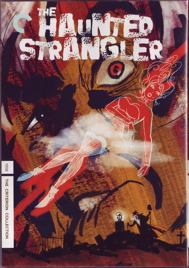
The Haunted Strangler
1958 / 79 min. / Grip of the Strangler
Starring Boris Karloff, Jean Kent, Elizabeth Allan, Vera Day, Anthony Dawson
Cinematography Lionel Banes
Production Design John Elphick
Special Effects Les Bowie
Film Editor Peter Mayhew
Original Music Buxton Orr
Written by John C. Cooper (John Croydon), Jan Read from his story Stranglehold
Produced by John Croydon, Richard Gordon
Directed by Robert Day
Producer Richard Gordon gave Boris Karloff a firm career boost with The Haunted Strangler, an exciting near-classic that affords Karloff a meaty center-of-attention role. Even when pushing seventy, Karloff the Uncanny shows 'em what a real actor can do: He conjures a frightening monster just by distorting his facial features.
The Haunted Strangler is a far better film than Karloff's horror vehicles from earlier in the decade, when Universal used him as marquee bait but only gave him glorified bits to play. Producer Richard Gordon was a loyal fan, and when Karloff found a script he liked, he brought it to his young friend. Gordon's brother Alex had used the same strategy several years before in Hollywood, on an effort that eventually devolved into the Ed Wood opus Bride of the Monster. But Richard found English investors and name actors eager to work with Karloff. The Haunted Strangler went into production and soon attracted the interest of MGM.
The smartly directed film uses ingredients in short supply in American horror pictures of the 1950s -- sympathetic characters and spooky 1930s lighting. None of these trappings are particularly artful or profound, but they focus our interest on Karloff's excellent performance. His Dr. Jekyll-like James Rankin has enough surprises to make us overlook the film's thin premise ... we're too busy enjoying Karloff to pick apart the story details.
Producer Gordon was delighted when Karloff proved that an elaborate makeup job wasn't needed. Just by taking out his false teeth, screwing up his face and half-closing his thick eyelids, Karloff transforms himself into a frightening boogeyman. An exaggerated walk and a twisted arm complete the illusion. We're told that Karloff removed a bridge and sucked his cheek in to aid his cadaverous appearance on the original Frankenstein. His minimal-makeup transformation in The Haunted Strangler is much better than Spencer Tracy's in Dr. Jekyll and Mr. Hyde.
Elizabeth Allan, a veteran of classic Hollywood pix (A Tale of Two Cities, Mark of the Vampire) is Karloff's distressed wife, while Jean Kent (The Browning Version, Bonjour Tristesse) and Vera Day (A Kid for Two Farthings) are showgirls and potential victims. Editor Peter Mayhew inter-cuts the music hall performances with the thriller action to good effect.
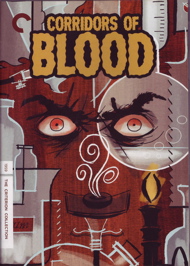
Corridors of Blood
1959 / 87 min.
Starring Boris Karloff, Betta St. John, Finlay Currie, Christopher Lee, Francis Matthews, Adrienne Corri, Francis De Wolff, Basil Dignam, Nigel Green, Yvonne Romain (Warren)
Cinematography Geoffrey Faithfull
Film Editor Peter Mayhew
Original Music Buxton Orr
Written by Jean Scott Rogers
Produced by John Croydon, Charles Vetter Jr., Richard Gordon
Directed by Robert Day
A budgetary boost from MGM elevates Corridors of Blood to a higher level of ambition. The story of medical experiments and bodysnatchings in Old London benefits from a great cast and handsome sets. The film has merit as a period thriller -- the bloody operations without anesthesia are historically accurate and therefore not exploitative. Karloff does well with his tragic role as the progressive doctor and Christopher Lee (given special billing!) is on hand as a creepy, colorful cutthroat.
The beautifully titled Corridors of Blood is a fascinating horror picture; like John Gilling's The Flesh and the Fiends it reaches for greater significance and almost makes it. Medical operations in 1840 are organized sadism. Modern notions of sterile tools or even cleanliness are nowhere to be seen. A surgery bell summons neighborhood laborers to help hold down the screaming patients. The primary requirement for a doctor is a strong stomach and an ability to block out distracting emotions. One doctor's favorite phrase is, "Pain and the knife are inseparable."
The story neatly dovetails the experiments of Karloff's Dr. Bolton with the murderous doings at a scurvy den of thieves. He has good support from his medical student son (Francis Matthews) and a sympathetic peer (Finlay Currie) but the conservative medical board obstructs his research.
Bolton's problems are completely different than those of that other cinematic anesthesiologist, Joel McCrea in Preston Sturges' The Great Moment. Bolton fails because he neglects to organize his research and testing. The doctor inhales noxious vapors and distillations of narcotics without so much as a witness, so that when he wakes up hours later, he can't properly document his experience. He doesn't realize that he's been down in the slum called Seven Dials, signing false death certificates that aid Black Ben and Resurrection Joe in their murder-for-profit schemes. "Physician, heal thyself"; but please don't experiment on yourself.
We meet plenty of colorful characters on the way. Francis de Wolff and Christopher Lee are joined in malice by Adrienne Corri's (The River, A Clockwork Orange) barmaid-schemer and various raggedy lackeys. Future horror pin-up girl Yvonne Romain (Circus of Horrors, Curse of the Werewolf) is an unwitting prostitute used to put clients in a receptive mood for Resurrection Joe's suffocation technique. Nigel Green is forceful as a cop shocked to find the distinguished Dr. Bolton when he raids Black Ben's house of corruption.
Back at the medical school, a jeering gallery watches Bolton's demonstrations fail. One patient bolts from the operating table to attack the laughing audience. His mind dulled by drugs, Bolton can no longer perform surgery with the necessary speed and precision, and is dismissed from his duties. It's no fun to watch the idealistic Bolton suffer these humiliations, and the film sags before the violent raid on Black Ben's gets it back on its feet again. Some grisly deaths remind us that we're watching a horror film.
Corridors of Blood has always been shown with obvious splices and erratic editing around censor cuts; disc producer Marc Walkow provides an extra that shows both the uncut footage and the censor rulings that mandated the deletions. The cuts amount to some tame but effective close-ups of stabbings, and one long shot of the first incision of an operation. The objection must have been that the patient screams bloody murder, for a closer angle on the same action was left intact for a later opium-warped flashback montage.
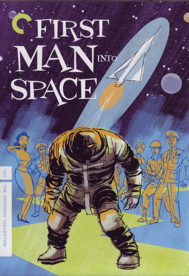
First Man into Space
1959 / 77 min.
Starring Marshall Thompson, Marla Landi, Bill Edwards, Robert Ayres, Bill Nagy
Cinematography Geoffrey Faithfull
Film Editor Peter Mayhew
Original Music Buxton Orr
Written by John C. Cooper (John Croydon), Lance Z. Hargreaves (Charles F. Vetter) from a story by Wyott Ordung
Produced by John Croydon, Charles Vetter jr., Richard Gordon
Directed by Robert Day
The least impressive but perhaps the most profitable of these four English films is First Man Into Space, a clever knock-off of Hammer's The Quatermass Xperiment timed to take advantage of the new Space Race. Executive producer Richard Gordon clearly put the majority of his resources into his Boris Karloff period pictures, leaving this Sci-Fi opus to make do with a surfeit of borrowed stock footage.
First Man Into Space is an exploitation monster movie with a formula that would be repeated by a score of impoverished Z-pictures: The Crawling Hand, Frankenstein Meets the Space Monster. The authorities are baffled when a bizarre string of killings eventually incriminate a mutated astronaut. Richard Gordon's minimalist effort uses few sets and was filmed in England with actors specializing in American accents. Stock shots of 1953 rocket planes and a few outer space special effect shots provide the production value; Bill Edwards' unlucky astronaut looks like he fell into a Kentucky Chicken deep fat fryer.
The humorless script started with an original by Wyott Ordung, the unheralded author of Target: Earth! and Phil Tucker's Robot Monster. Scientific doubletalk rationalizes Dan's rubberized costume. Things get pretty silly when the various eggheads and officers are reluctant to conclude that Dan is the killer, even in the face of multiple pieces of evidence. Marla Landi is present for some kissing scenes and an expected shift of affections to the brother whose face doesn't look like a fried egg.
The unlucky astronaut is disoriented and in terrible pain until his associates get him into a pressure chamber, but that doesn't explain why he behaves like a cross between The Golem and Dracula. The script offers some weak dialogue about needing blood (?), which we mostly ignore. Dan was an egotistical jerk who turned into a monster and then said he was sorry before kicking off. End of story.
The movie's silliest scene has a faux Mexican (Roger Delgado) complaining about off-course American missiles; one even buzzed a major bullfight. The Americans politely patronize him. The duds have to go somewhere, don't they? Sheesh.
First Man Into Space was boosted from second-bill status to a main feature and did exceedingly well for its producers. It's more smoothly directed, but less interesting than the previous MGM release Fiend Without A Face.
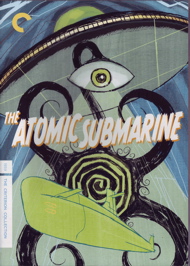
The Atomic Submarine
1959 / 72 min.
Starring Arthur Franz, Dick Foran, Brett Halsey, Paul Dubov, Bob Steele, Victor Varconi, Joi Lansing, Jean Moorhead, Sid Melton, Tom Conway
Cinematography Gilbert Warrenton
Special Effects Irving Block, Louis DeWitt, Jack Rabin
Art Direction Don Ament, Daniel Haller
Film Editor William Austin
Original Electro-sonic Music Alexander Laszlo
Written by Orville H. Hampton
Produced by Alex Gordon
Directed by Spencer Gordon Bennet
The Atomic Submarine is from Richard's brother Alex, another super-fan turned producer. A thoroughly silly adventure released by the penny-pinching Allied Artists studio, it's nevertheless one of the Gordons' better known efforts and has remained popular for its retro cast of 30s and 40s actors. By the 1950s the industry already considered Dick Foran and Tom Conway to be has-beens, but knowledgeable movie fans appreciated seeing the stars of their favorite serials and action adventures.
In 1958 the nuclear sub Nautilus completed a voyage under the polar ice. Following the example of First Man Into Space, The Atomic Submarine used an ad campaign that stressed the topical subject matter, giving no clue that its submarine would be doing battle with a monster from a UUO (Unidentified Underwater Object).
Well, now we know the source of the seed concept for James Cameron's The Abyss. Starting with the loss of an atomic submarine, what begins as a futuristic straight adventure takes an abrupt turn into science fiction fantasy. The Atomic Submarine's production shortcomings are almost too obvious to mention. Besides being filmed on unconvincing sets (say, that's a really roomy sub!) an awful lot of the movie simply shows the same five or six unconcerned-looking actors standing around talking. The stock shots are in crummy shape and the meager effects by Messrs. Block, Rabin and DeWitt are simply not convincing. The pale submarines look like they're carved out of soap. The models have a hard time staying in focus and seem to forever be passing the same undersea rocks.
What every kid remembers is the film's exciting commando raid into the interior of the UFO that the submariners dub "Cyclops." The ultra-minimalist blackness of the saucer interior is fairly creepy, and three of the commandos meet weird, gruesome deaths. "You call that a face?" is Arthur Franz' honest reaction to the Bug-Eyed, tentacled horror he finds at the ship's center. It has only one eye, so the Cyclops name fits after all. Small kids remember the way that both the saucer and the alien automatically heal themselves, along with the grotesque sight of a commando cut in two by a closing iris doorway. "Fortunes of war", quips our tough guy hero, as the U.S. Navy saves the world.
Gordon's main contribution seems to be to assemble a cast of amiable old timers. Dick Foran, Tom Conway, Victor Varconi and Bob Steele can't do much with Spencer G. Bennet's one-take direction. Arthur Franz looks unhappy but at least his macho rivalry with Brett Halsey is neatly resolved. The clownish personalities in the cast either have brief bits (Sid Melton) or are not allowed to make a big impression (Paul Dubov). However, the saucer and monster aspects went over big with the kiddie crowd.
The Monsters and Madmen boxed set actually began several years ago at Image Entertainment, when the commentaries with Alex Gordon were recorded. The titles have since been percolating at Criterion, awaiting the launch of a secondary cult/genre DVD label that never came about.
The insert notes wrongly claim that these late-50s films are transferred "in their original 1.33:1 aspect ratios." By that time, almost all releases were formatted 1.66:1 or even wider. The Sci-Fi pictures leave a lot of dead space at the bottom of the frame, and it looks as if the transfer people have adjusted the scan for different scenes. First Man Into Space is listed as 1.66:1 in its original Variety review, but in this transfer its main title crowds the frame and doesn't crop well. Compositions on both of the Karloff pictures are far too tight, especially so on the sides, which indicates that they have probably been slightly enlarged as well. The transfers originated from the Monsters HD channel and are otherwise flawless, and with excellent audio.
Disc producer Marc Walkow has come up with a satisfying group of extras. Featurettes from Michael Lennick (who did excellent work on the Videodrome disc) use interviews filmed by Tom Weaver, who also hosts good commentaries with the Gordon brothers. The interview material looks to be filmed on DVCam and varies greatly in quality. Vera Day, Jean Kent, Marla Landi, Brett Halsey, Francis Matthews and director Robert Day all appear and share their memories, which are often substantial. As can be expected, everyone who knew Boris Karloff seems to have loved him.
Tom Weaver interviews the same two men for all four pictures, with the amiable Yvonne Romain adding a number of memories to the track for Corridors of Blood. The only title that drags at times is the one for The Atomic Submarine, and mainly because the enthusiastic Alex Gordon talks too much about his favorite actors' work in unrelated pictures. Elsewhere Weaver keeps things lively and informative.
Richard Gordon gives a full rundown on his work before his fantasy films and details the problems he and his brother had trying to get a picture going in Hollywood in the early 1950s. Challenged to assemble a reasonable feature package, the Gordons used their personal charm and fan contacts to put together the horror dream team of Karloff, Bela Lugosi and Lon Chaney. When they showed their plan to the studio production men, they were told that the package was good but they "didn't have enough experience."
Until Alex connected with Roger Corman and the A.I.P. crowd, and Richard made his deals with Boris Karloff, they floundered with the likes of other hopefuls, including Ed Wood. Richard says that Ed Wood was likely one of the people sent to the desert to get a couple of connecting shots for the American-set but England-filmed First Man Into Space.
The Karloff pictures are very entertaining, and the cut-price Sci-Fi pictures have their attractions as well. Fantasy fans already acquainted with them will probably want to go straight to the Weaver commentaries.
Original trailers and an ad and still gallery complete the extras. The arresting graphic treatment on the packaging and menus are reminiscent of old Disneyland poster artwork. That's a good call, as the original posters for these films were not very attractive. The bushy mad-doctor eyebrows on the Corridors of Blood box do look like a borrowing from the poster for Blood of the Vampire. Insert booklets include essays by critics Maitland McDonough, Bruce Eder, Michael Lennick and producer John Croyden.
On a scale of Excellent, Good, Fair, and Poor,
|
The Haunted Strangler rates:
Movie: Very Good ++ Video: Very Good Sound: Excellent |
Corridors of Blood rates:
Movie: Very Good + Video: Very Good Sound: Excellent |
|
First Man into Space rates:
Movie: Good -- Video: Very Good Sound: Excellent |
The Atomic Submarine rates:
Movie: Good - Video: Good Sound: Very Good |
Packaging: four discs in two keep cases in card sleeve.
Supplements: Interview featurettes, Tom Weaver commentaries with Richard and Alex Gordon, Trailers, still and Advertising poster galleries; Censored scenes on Corridors of Blood
Reviewed: January 8, 2007
Review Staff | About DVD Talk | Newsletter Subscribe | Join DVD Talk Forum
Copyright © MH Sub I, LLC dba Internet Brands. | Privacy Policy | Terms of Use
|
| Release List | Reviews | Price Search | Shop | SUBSCRIBE | Forum | DVD Giveaways | Blu-Ray/ HD DVD | Advertise |





